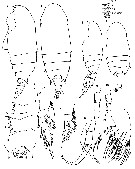
issued from : A. Fleminger
in Fish. Bull. Fish Wildl. Serv., 1957, 57 (117). [p.357, Pl. 1].
Female (from G. of Mexico): 1-2, habitus (lateral and dorsal, respectively); 6 b, Md (cutting edge); 7, P2; 8, P1; 9, endopod of P4; 10, endopod of P3; 11, genital segment (ventral); 13, Mx2; b, Md (cutting edge.
Nota: A1 24-segmented, as long as cephalothorax less spiniform processes of last segment.
Md with dentition differing from that in
B. armatus; teeth more numerous, those on ventral half of of gnathal lobe overlapping.
Mx2 with short seta on lobes 2-4, each with closely spaced row of spinules on proximal portion; falcate spine on lobe 5 with closely spaced rowof short hairs.
Remaining cephalic appendages similar to those in
B. armatus.
Proportional lengths of urosomal segments (caudal rami included; segments 4 and 5 taken together) 39 : 19: 20: 22 = 100.
Male: 3-4, lateral and dorsal); 5, rostrum; 6, Md (cutting edge);12, P5.
Nota: Differs from
B. pacificus and
B. similis chiefly in details of P5.
Proportional lengths of urosomal segments (segments 4 and 5 taken together) 15: 29: 21: 19: 16 = 100. A1 extending to caudal rami, right A1 20-segmented (primitive segments 8-10, 12-13, 20-21, 24-25 fused).
Stage V Male: 6 a, Md (cutting edge).
Nota: Mandibular gnathal lobe (fig.6a) apparently similar to that in
B. armatus 



